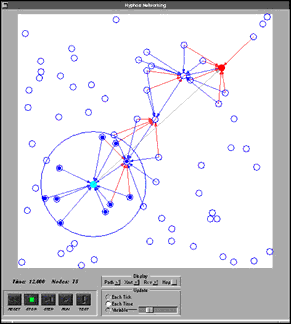

... a wireless, self-organizing network
In the near future, many everyday objects will be connected to digital networks, giving rise to Things That Think. In becoming integrated into larger networks, common objects can acquire personalized behavior and memory.But how can you can you make a thousand network connections in one room? How can you interconnect these objects without a tangle of wires, burden of battery packs, or Ph.D. in network administration?
Hyphos (from the Greek word for web), is a wireless, self-organizing digital network. Each node in the network communicates only with its immediate neighbors. Neighbors relay messages to their neighbors in turn until the message reaches its destination.
Each node in a Hyphos Network:
- is autonomous, acting as its own router
- consumes very little power, designed to run on a watch battery or parasitic power
- transmits over a localized area, conserving bandwidth in the airwaves
- is homogenous; there's no distinction between "mobile nodes" and "land stations"
- is mobile; can move freely in the environment
- is low cost; can be constructed on a single silicon chip
The overall Hyphos Network:
- is self-organizing, dynamically sets up routing
- is self-configuring, requiring no pre-existing wiring or infrastructure
- is self-healing, adapting automatically as nodes move or vanish
